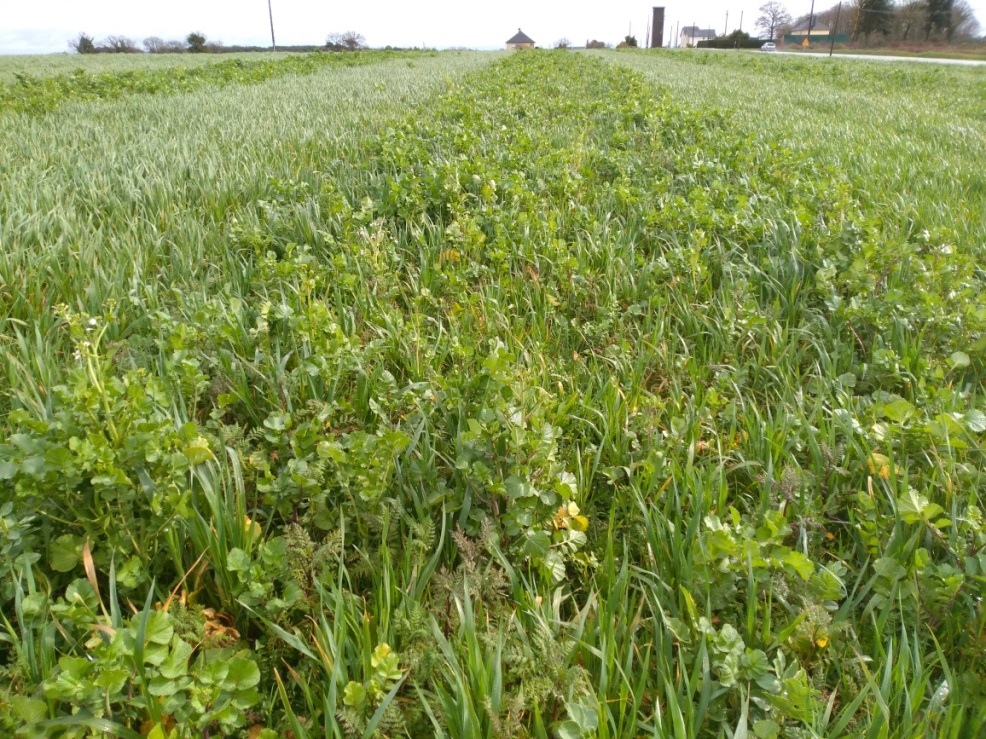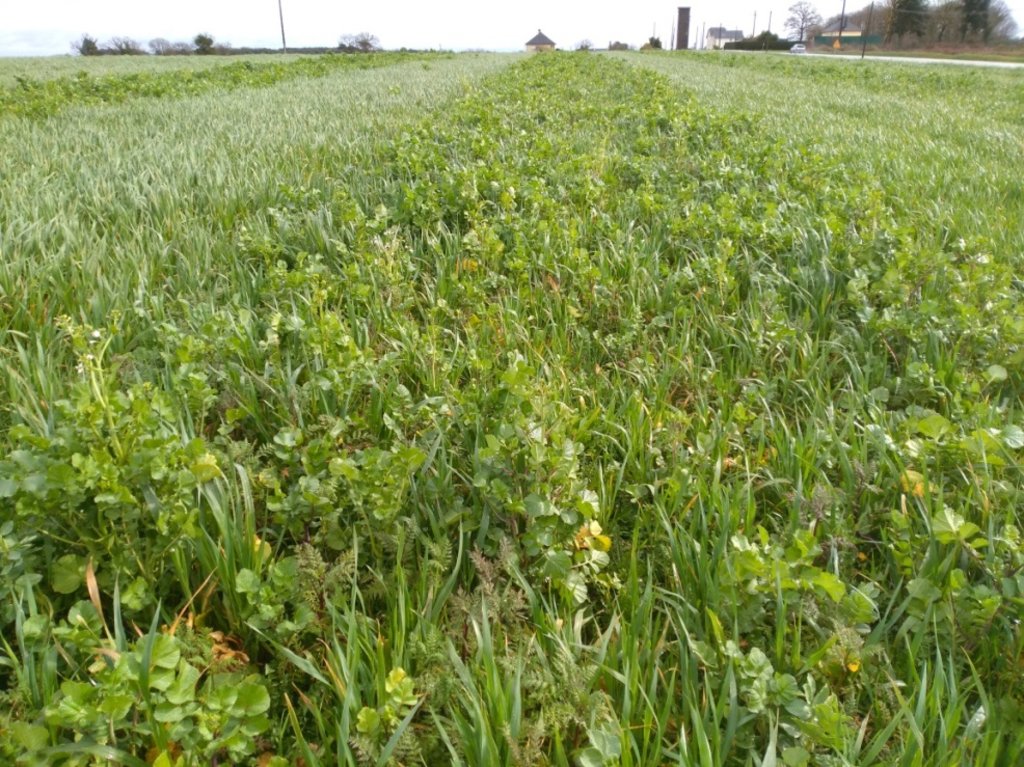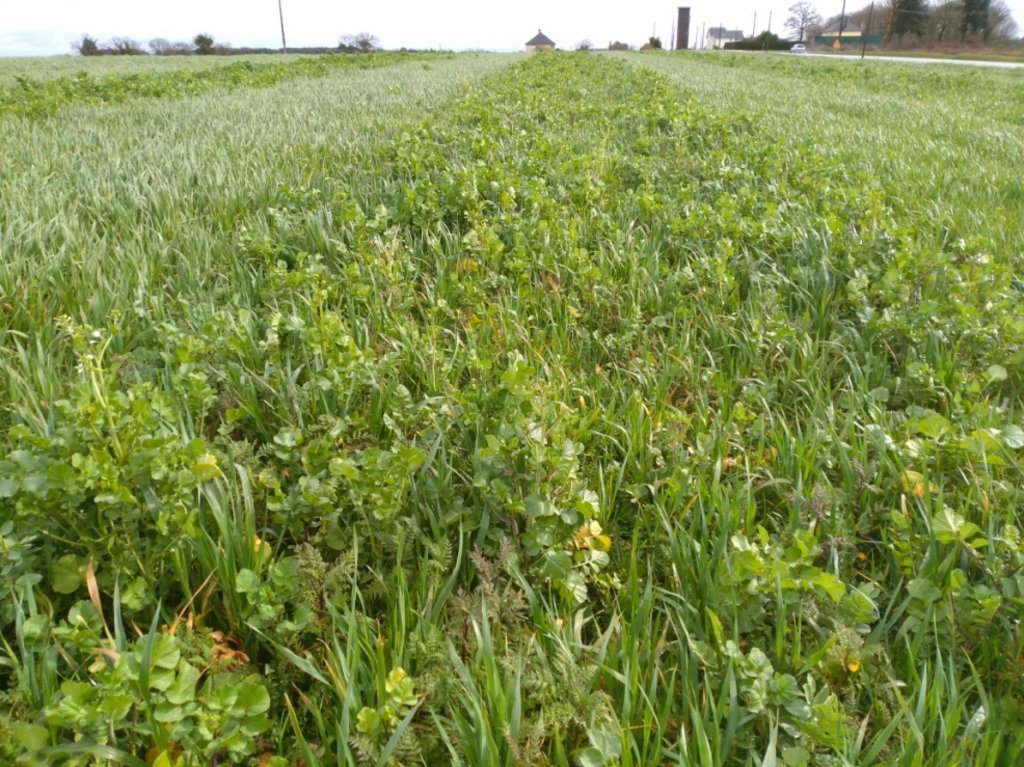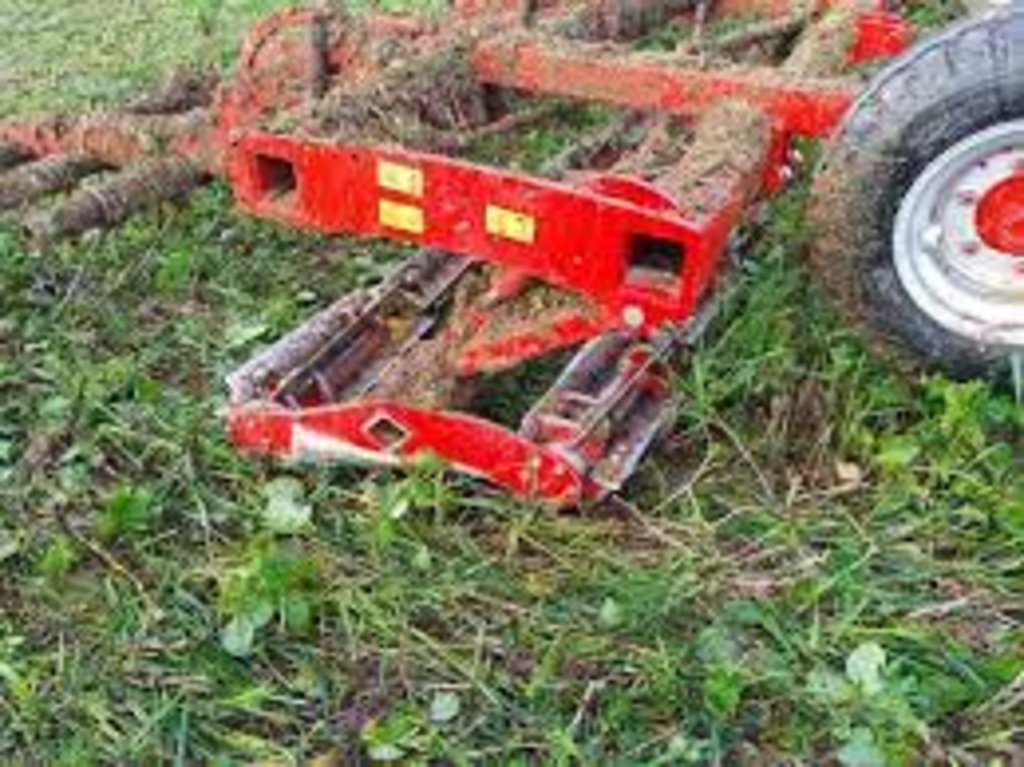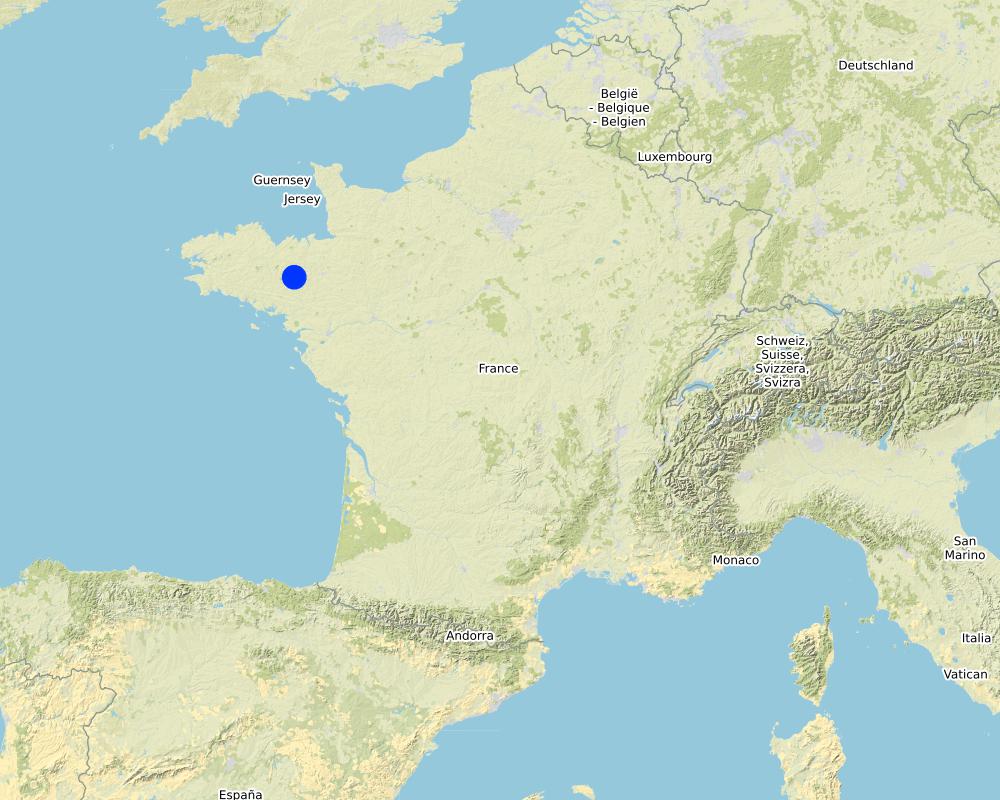Vegetation cover management on an organic, mixed livestock-crop farm [فرنسا]
- تاريخ الإنشاء:
- تحديث:
- جامع المعلومات: Alan Radbourne
- المحررون: David Robinson, David Norris, Sabine Reinsch
- المراجعون: Rima Mekdaschi Studer, William Critchley
technologies_5680 - فرنسا
عرض الأقسام
توسيع الكل طي الكل1. معلومات عامة
1.2 تفاصيل الاتصال بالأشخاص الرئيسيين لمصدر المعلومات والمؤسسات المشاركة في تقييم وتوثيق التقنية
الشخص (الأشخاص) الرئيسي لمصدر المعلومات
جامع المعلومات المشارك:
Joubioux Christiane
Chambre regionale d'agriculture de Bretane: Regional chambre of agriculture of Brittany
فرنسا
مستخدم الأرض:
Le Callonnec Patrice
NA
فرنسا
متخصص في الإدارة المستدامة للأراضي:
Guiet Sylvie
Chambre regionale d'agriculture de Bretane: Regional chambre of agriculture of Brittany
فرنسا
اسم المشروع الذي سهّل توثيق/تقييم التقنية (إذا كان ذلك على صلة)
European Interreg project FABulous Farmersاسم المؤسسة (المؤسسات) التي سهلت توثيق/تقييم التقنية (إذا كان ذلك على صلة)
UK Centre for Ecology & Hydrology (CEH) - المملكة المتحدةاسم المؤسسة (المؤسسات) التي سهلت توثيق/تقييم التقنية (إذا كان ذلك على صلة)
Association des Chambres d’agriculture de l’Arc Atlantique (AC3A) - فرنسا1.3 الشروط المتعلقة باستخدام البيانات الموثقة من خلال WOCAT
يوافق جامع المعلومات والشخص (لاشخاص) الرئيسي لمصدر المعلومات على الشروط المتعلقة باستخدام البيانات الموثقة من خلال WOCAT:
نعم
1.4 إعلان بشأن استدامة التقنية الموصوفة
هل التقنية الموصوفة هنا تمثل مشكلة فيما يتعلق بتدهور الأراضي، بحيث لا يمكن إعلانها تقنية مستدامة لإدارة الأراضي؟:
كلا
2. وصف تقنيةالإدارة المستدامي للأراضي
2.1 وصف مختصر للتقنية
تعريف التقنية:
Use of different mixes of plant cover for livestock fodder which are simultaneously favourable for biodiversity by improving soil health, and reducing the need for agrochemicals.
2.2 وصف تفصيلي للتقنية
الوصف:
Agriculture in Brittany, in the north-west of France, is known for fish, beef, pork, poultry, vegetables and milk. Cover crops are used by farmers of Mauron, and the example described here is from a farm located in Morbihan in the basin known as Ploërmel. In this warm temperate area the average annual rainfall is 650-700 mm with an annual temperature of around 11°C.
There are three types of cover crops included in the rotation. These are selected on the basis of their benefits in relation to soil fertility and fodder production, in order to improve the farm's food self-sufficiency. There are three basic types of cover crops, as follows.
1) “Protein mixes” are composed of 35% faba (broad) beans, 26% oats, 17.5% peas, 17.5% vetch, and 4% clover. These are sown in early October after grass or maize are made into silage at the end of April.
2) "Green manure" cover crops are sown at the beginning of September after cereals, and are composed of various complementary species with the main objective of preserving and strengthening soil life (i.e. worm abundance), and winter feeding of heifers. For example, the commercial "Biomax" mix contains seeds of broad bean, vetch, clover, phacelia and radish. These cover crops are enriched by the presence of approximately 50% ryegrass regrowth, supporting the development of soil life.
3) Rapeseed is sown after cereals as a crop rotation feedstock and are made into silage.
Cover crops are either broadcast and rolled, or direct seeded depending on the conditions of the post-harvest plots. The seed drill used is equipped with discs to minimise soil disturbance as a reduced tillage technique, but more important in this respect is the presence of crop residues (i.e. straw). The seed drill is also equipped with tines.
The cover crops are grazed by heifers in a rotational 2-day paddock set-up. After grazing and regrowth of the ryegrass present, the fields may be left to develop into pasture, or seeded to crops using a minimum tillage drill.
The purposes are:
•Improved production
•Countered land degradation
•Protected watersheds
•Preserved biodiversity
•Adaptation to climate change/extreme events
The benefits are:
•Sustained ecosystem health: no pest and disease problems, good herd health
•Enrichment of the soil by the addition of carbon in organic matter and by the work of earthworms - favouring ecosystem functioning
•Protection of the soil and surface biodiversity because of maintained plant cover
•Increased weed control due to plant canopies and fertilisation effect of green manure
•Planted cover crops used as livestock feed during winter
The challenges are:
•Potential difficulties in establishing plant cover (especially in dry areas)
•Late sowing of cover crops reduces beneficial effects
•High costs of seed mixtures with high protein cover crops
2.3 صور التقنية
2.5 البلد/المنطقة/المواقع التي تم تنفيذ التقنية فيها والتي يغطيها هذا التقييم
البلد:
فرنسا
المنطقة/الولاية/المحافظة:
Brittany
مزيد من التفاصيل حول الموقع:
Mauron
حدد انتشار التقنية:
- منتشرة بالتساوي على مساحة
إذا كانت المساحة الدقيقة غير معروفة، فيرجى الإشارة إلى المنطقة التقريبية المغطاة:
- 100-10 كم2
هل يقع موقع/مواقع التقنية في منطقة محمية بشكل دائم؟:
كلا
Map
×2.6 تاريخ التنفيذ
اذكر سنة التنفيذ:
2019
في حالة عدم معرفة السنة بالتحديد، يرجى الإشارة إلى التاريخ التقريبي:
- منذ أقل من 10 سنوات (مؤخرًا)
2.7 إدخال التقنية
حدد كيف تم إدخال التقنية:
- من خلال ابتكار مستخدمي الأراضي
- كجزء من النظام التقليدي (> 50 عامًا)
التعليقات (نوع المشروع، الخ):
In order to make their production system evolve, farmers and their associates are eager for information. They do not hesitate to go and see what is happening elsewhere and to consult: training, visits, reading, internet, exchanges. The land user is a member of the BASE (Biodiversity Agriculture Soil and Environment) network and the Ecosystem association. Breeders do not hesitate to test new production practices on their farms.
3. تصنيف تقنية الإدارة المستدامي للأراضي
3.1 الغرض الرئيسي ( الأغراض الرئيسية) للتقنية
- تحسين الإنتاج
- الحد من تدهور الأراضي ومنعه وعكسه
- حماية مستجمعات المياه / المناطق الواقعة في اتجاه مجرى النهر - مع تقنيات أخرى
- الحفاظ على/تحسين التنوع البيولوجي
- التكيف مع تغير المناخ/الظواهر المتطرفة وآثارها
3.2 نوع (أنواع) استخدام الأراضي الحالية حيث يتم تطبيق التقنية
استخدامات الأراضي مختلطة ضمن نفس وحدة الأرض:
نعم
حدد استخدام الأراضي المختلطة (المحاصيل / الرعي / الأشجار):
- الرعي الزراعي (بما في ذلك الإدارة المتكاملة للمحاصيل والثروة الحيوانية)

الأراضي الزراعية
- زراعة سنوية
- Cover crops
الزراعة السنوية - حدد المحاصيل:
- الحبوب - الذرة
- الحبوب - شيلم
- محاصيل الأعلاف - النفل
- محاصيل الأعلاف - الأعشاب
- محاصيل الأعلاف - أخرى
- الحبوب البقولية والبقول- الفاصوليا
- المحاصيل الزيتية - عباد الشمس، بذور اللفت، وغيرها
عدد مواسم الزراعة في السنة:
- 1
هل يتم ممارسة الزراعة البينية؟:
نعم
إذا كانت الإجابة بنعم، حدد المحاصيل التي يتم زراعتها بشكل بيني:
protein mix, a multi-species green manure, and a rapeseed mix
هل تتم ممارسة تناوب المحاصيل؟:
نعم
إذا كانت الإجابة بنعم، حدد:
Maize, grassland

أراضي الرعي
الرعي المكثف/ إنتاج الأعلاف:
- قطع وحمل / صفر مرعى
- مراعي محسنة
نوع الحيوان:
- ماشية - الألبان
- الدواجن
هل يتم تطبيق الإدارة المتكاملة للمحاصيل والثروة الحيوانية؟:
نعم
إذا كانت الإجابة بنعم، حدد:
Dairy and poultry moved across crop for fodder and cross benefits of fertilisation.
الصنف:
ماشية - الألبان
العدد:
115
الصنف:
الدواجن
العدد:
4500
3.3 هل تغير استخدام الأراضي نتيجة لتنفيذ التقنية؟
هل تغير استخدام الأراضي نتيجة لتنفيذ التقنية؟:
- لا (تابع مع السؤال 3.4)
3.4 إمدادات المياه
إمدادات المياه للأرض التي يتم تنفيذ التقنية عليها:
- بعلية
3.5 مجموعةالإدارة المستدامة للأراضي التي تنتمي إليها هذه التقنية
- الإدارة المتكاملة للمحاصيل والثروة الحيوانية
- تحسين الغطاء الأرضي/النباتي
- الإدارة المتكاملة للآفات والأمراض (بما في ذلك الزراعة العضوية)
3.6 التدابير التقنية في مجال إلادارة المستدامة للأراضي

التدابير الزراعية
- A1: الغطاء النباتي/التربة
- A2: المادة العضوية/خصوبة التربة
- A3: معالجة سطح التربة
- A4: المعالجة تحت السطحية
3.7 الأنواع الرئيسية من تدهور الأراضي التي تناولتها التقنية

تآكل التربة بالمياه
- الوزن(Wt): فقدان التربة السطحية/تآكل السطح
- (Wg):الانجراف الخلجاني/ الخلجان
- (Wo:) تأثيرات التدهور من مواقع أخرى

التدهور الكيميائي للتربة
- (Cn): تراجع الخصوبة وانخفاض محتوى المادة العضوية (غير ناتج عن الانجراف)

التدهور المادي أو الفيزيائي للتربة
- (Pc) : تراص التربة

التدهور البيولوجي
- (Bc): تناقص الغطاء النباتي
- (Bq): انخفاض الكمية/الكتلة الحيوية
- (Bs): انخفاض جودة وتركيبة الأنواع/التنوع
- (Bp): زيادة الآفات/الأمراض، وفقدان الحيوانات المفترسة

تدهور المياه
- (Hp): تدهور نوعية المياه السطحية
- (Hw): تناقص القدرة التخفيفية للمناطق الرطبة
3.8 منع أو حد أو عكس تدهور الأراضي
تحديد هدف التقنية فيما يتعلق بتدهور الأراضي:
- منع تدهور الأراضي
- الحد من تدهور الأراضي
4. المواصفات الفنية، وأنشطة التنفيذ، والمدخلات، والتكاليف
4.1 الرسم الفني للتقنية
المواصفات الفنية (المتعلقة بالرسم الفني):
- broadcast sowing or direct sowing of species mixture in late August / early September or late September / early October
- protein mix: peas 40 kg / faba (broad) beans 80 kg / vetch 40 kg / clover 8 kg / oats 60 kg per hectare
- Biomax mix: radish 2 kg / clover 3 kg / faba (broad) bean 20 kg / phacelia 2 kg / vetch 10 kg per hectare
- Rapeseed mix: 8 to 10 kg per hectare
المؤلف:
Revue agricole Terra
التاريخ:
21/06/2013
4.2 معلومات عامة بخصوص حساب المدخلات والتكاليف
حدد كيفية احتساب التكاليف والمدخلات:
- حسب مساحة تنفيذ التقنية
الإشارة إلى حجم ووحدة المساحة:
1 ha
عملة أخرى/ عملة وطنية (حدد):
€
إذا كان ذا صلة، وضح سعر الصرف من الدولار الأمريكي إلى العملة المحلية (على سبيل المثال، 1 دولار أمريكي = 79.9 ريال برازيلي): 1 دولار أمريكي =:
0,9
اذكر متوسط تكلفة أجر العمالة المستأجرة في اليوم الواحد:
Gross hourly minimum wage: €10.15 on 1 January 2020, i.e. €1,539.42 monthly on the basis of the legal working week of 35 hours.
4.3 أنشطة التأسيس
| النشاط | التوقيت (الموسم) | |
|---|---|---|
| 1. | Soil preparation and subsequent sowing of rapeseed/rapeseed after harvest cereals | End of August |
| 2. | Soil preparation and sowing of the Biomax mixture after harvest cereals | End of August |
| 3. | Soil preparation and sowing of meslin after grassland or corn on the cob | End of October |
| 4. | Rapeseed/rapeseed grazing and growing of green manure | December to March |
| 5. | Meslin silage | April |
4.4 التكاليف والمدخلات اللازمة للتأسيس
| تحديد المدخلات | الوحدة | الكمية | التكاليف لكل وحدة | إجمالي التكاليف لكل مدخل | % من التكاليف التي يتحملها مستخدمو الأراضي | |
|---|---|---|---|---|---|---|
| معدات | Direct seeding (compil) | ha | 40,0 | 60,0 | 2400,0 | 100,0 |
| معدات | Broadcast sowing | ha | 72,0 | 15,0 | 1080,0 | 100,0 |
| معدات | Roller spade before sowing (1 pass) | ha | 72,0 | 23,0 | 1656,0 | 100,0 |
| معدات | Maceration by a roller with blades | ha | 224,0 | 23,0 | 5152,0 | 100,0 |
| المواد النباتية | Seeds - protein blend | ha | 60,0 | 394,0 | 23640,0 | 100,0 |
| المواد النباتية | Seeds - forage rapeseed | ha | 17,0 | 28,0 | 476,0 | 100,0 |
| المواد النباتية | Seeds - green manure "biomax" fertilizer | ha | 18,0 | 60,0 | 1080,0 | 100,0 |
| إجمالي تكاليف إنشاء التقنية | 35484,0 | |||||
| إجمالي تكاليف إنشاء التقنية بالدولار الأمريكي | 39426,67 | |||||
التعليقات:
Costs for seeds refer to purchased seed, if farm-saved seed, the cost is reduced
4.5 الصيانة/الأنشطة المتكررة
التعليقات:
No maintenance costs just time to rotationally graze livestock and poultry
4.6 التكاليف والمدخلات اللازمة للصيانة/للأنشطة المتكررة (سنويًا)
التعليقات:
No maintenance activities, future years would repeat establishment activities
4.7 أهم العوامل المؤثرة على التكاليف
قدم وصفا لأهم العوامل التي تؤثر على التكاليف:
Direct sowing equipment, destruction with 2 passes of rolling spade, cost of purchasing "biomax" mixture
5. البيئة الطبيعية والبشرية
5.1 المناخ
هطول الأمطار السنوي
- < 250 مم
- 251- 500 ملم
- 501 - 750ملم
- 1,000-751 ملم
- 1,500-1,100 ملم
- 2,000-1,500 ملم
- 3,000-2,001 ملم
- 4,000-3,100 ملم
- > 4000 ملم
حدد متوسط هطول الأمطار السنوي (إذا كان معروفًا)، بالملليمتر:
675,00
المواصفات/التعليقات على هطول الأمطار:
The farm is located on the commune of Mauron in Morbihan and is in an early agro-climatic zone. The average annual rainfall of 650-700 mm is the lowest in Morbihan. The average annual temperature of around 11°C and is also the lowest in Morbihan.
الإشارة إلى اسم محطة الأرصاد الجوية المرجعية المعنية:
Ploermel
المنطقة المناخية الزراعية
- شبه رطبة
The climate of Mauron is warm and temperate. It is in the basin known as Ploërmel, the most continental of Morbihan with colder winters, hotter summers and rainfall of around 650-700 mm/year. Heavy showers fall all year round in the area of Mauron. Even in the driest months, rainfall remains fairly heavy.
5.2 طوبوغرافيا
متوسط الانحدارات:
- مسطح (0-2%)
- بسيط (3-5%)
- معتدل (6-10%)
- متدحرج (11-15%)
- تلال (16-30%)
- شديدة الانحدار(31-60%)
- فائقة الانحدار (>60%)
التضاريس:
- هضاب/سهول
- أثلام مرتفعة
- المنحدرات الجبلية
- منحدرات التلال
- منحدرات في السفوح
- قاع الوادي
المنطقة الارتفاعية:
- 100-0 متر فوق سطح البحر
- 500-101 متر فوق سطح البحر
- 1,000-501 متر فوق سطح البحر
- 1,500-1,001 متر فوق سطح البحر
- 2,000-1,501 متر فوق سطح البحر
- 2,500-2,100 متر فوق سطح البحر
- 3,000-2,501 متر فوق سطح البحر
- 4,000-3,001 متر فوق سطح البحر
- > 4000 متر فوق سطح البحر
وضح ما إذا كانت التقنية مطبقة على وجه التحديد في:
- غير ذات صلة
التعليقات والمواصفات الإضافية بشأن التضاريس:
The minimum and maximum altitudes in Mauron are 47 m and 130 m respectively.
5.3 التربة
متوسط عمق التربة:
- ضحل جدًا (0-20 سم)
- ضحلة (21-50 سم)
- متوسطة العمق (51-80 سم)
- عميقة (81-120 سم)
- عميقة جدًا (> 120 سم)
قوام التربة (التربة السطحية):
- متوسط ( طميي، سلتي)
قوام التربة (> 20 سم تحت السطح):
- خشن / خفيف (رملي)
- متوسط ( طميي، سلتي)
المواد العضوية في التربة السطحية:
- عالية (>3%)
إذا كان متاحًا، قم بإرفاق وصف كامل للتربة أو تحديد المعلومات المتوفرة، على سبيل المثال نوع التربة، الرقم الهيدروجيني/ درجة حموضة التربة، قدرة التبادل الكاتيوني، النيتروجين، الملوحة وما إلى ذلك.
The farm is located in the commune of Mauron in Morbihan and is in the geological zone of the Briovician shales.
It contains :
UCS n°4034 Brown soils gradually leached from the plains and plateaus from locally soft schist sandstone.
UCS n°4022 Shallow, sometimes podzolic soils of locally sandstone mounds and brown leached soils of open plains, derived from soft schist.
5.4 توافر المياه ونوعيتها
منسوب المياه الجوفية:
50-5 م
توافر المياه السطحية:
متوسط
نوعية المياه (غير المعالجة):
مياه الشرب سيئة (تتطلب معالجة)
تشير جودة المياه إلى:
المياه الجوفية والسطحية
هل تعتبر ملوحة الماء مشكلة؟:
كلا
هل تحدث فيضانات في المنطقة؟:
كلا
5.5 التنوع البيولوجي
تنوع الأنواع:
- مرتفع
تنوع الموائل:
- مرتفع
5.6 خصائص مستخدمي الأراضي الذين يطبقون التقنية
مستقر أو مرتحل:
- غير المترحل
التوجه السوقي لنظام الإنتاج:
- تجاري/سوق
الدخل من خارج المزرعة:
- أقل من % 10من كامل الدخل
المستوى النسبي للثروة:
- متوسط
أفراداً أو مجموعات:
- المجموعات/ المجتمع المحلي
مستوى المكننة:
- ميكانيكية/ مزودة بمحرك
الجنس:
- رجال
عمر مستخدمي الأرضي:
- شباب
- متوسط العمر
5.7 متوسط مساحة الأرض التي يستخدمها مستخدمو الأراضي الذين يطبقون التقنية
- < 0.5 هكتارا
- 0.5 - 1 هكتار
- 1 -2 هكتار
- 2 - 5 هكتار
- 5 - 15 هكتار
- 15 - 50 هكتار
- 50 - 100هكتار
- 500-100 هكتار
- 1,000-500 هكتار
- 10,000-1,000 هكتار
- > 10,000 هكتار
هل يعتبر هذا نطاقًا صغيرًا أو متوسطًا أو واسعا (في إشارة إلى السياق المحلي)؟:
- على نطاق واسع
التعليقات:
The farm has been involved in organic farming since 1964 when Claudine's father settled on a 45-hectare dairy farm. The regrouping was carried out in 1968.
As the associates' facilities have been installed, the size of the farm has increased to reach a useful agricultural area of 220 hectares in 2020.
The farm has 3 main operating areas:
- dairy cattle with about 115 dairy cows (average of 7 to 8000 litres/year),
- poultry with 4500 laying hens, and a
- production of cash crops.
5.8 ملكية الأراضي، وحقوق استخدام الأراضي، وحقوق استخدام المياه
ملكية الارض:
- فردية، يوجد سند ملكية
حقوق استخدام الأراضي:
- مؤجر
- provisioning
حقوق استخدام المياه:
- فردي
هل تعتمد حقوق استخدام الأراضي على نظام قانوني تقليدي؟:
نعم
حدد:
lease
5.9 الوصول إلى الخدمات والبنية التحتية
الصحة:
- ضعيف
- معتدل
- جيد
التعليم:
- ضعيف
- معتدل
- جيد
المساعدة التقنية:
- ضعيف
- معتدل
- جيد
العمل (على سبيل المثال خارج المزرعة):
- ضعيف
- معتدل
- جيد
الأسواق:
- ضعيف
- معتدل
- جيد
الطاقة:
- ضعيف
- معتدل
- جيد
الطرق والنقل:
- ضعيف
- معتدل
- جيد
مياه الشرب وخدمات الصرف الصحي:
- ضعيف
- معتدل
- جيد
الخدمات المالية:
- ضعيف
- معتدل
- جيد
6. الآثار والتصريحات الختامية
6.1 الآثار التي أظهرتها التقنية في الموقع
الآثار الاجتماعية والاقتصادية
الإنتاج
إنتاج المحاصيل
التعليقات/ حدد:
Improved soil health and diversity with reduces pest issues
جودة المحاصيل
التعليقات/ حدد:
Improved soil health and diversity with reduces pest issues
إنتاج الأعلاف
التعليقات/ حدد:
Improved soil health and diversity with reduces pest issues
جودة العلف
التعليقات/ حدد:
Improved soil health and diversity with reduces pest issues
إنتاج حيواني
التعليقات/ حدد:
Better diversity of fodder available is producing healthier and better quality animals
تنوع المنتج
التعليقات/ حدد:
Sward mix in cover crop is very diverse
توافر المياه ونوعيتها
نوعية مياه الشرب
التعليقات/ حدد:
Cover crops reduce soil wash-off and other water quality related impacts
توافر المياه للماشية
التعليقات/ حدد:
Cover crops reduce soil wash-off and other water related loss impacts
نوعية المياه للماشية
التعليقات/ حدد:
Cover crops reduce soil wash-off and other water quality related impacts
الدخل والتكاليف
دخل المزرعة
التعليقات/ حدد:
Improved crop and animal production
عبء العمل
التعليقات/ حدد:
Greater workload to rotationally graze and manage crop effectively in an organic system (i.e. can't rely on spraying to solve problems). Yet, benefits outweigh extra workload.
الآثار الاجتماعية والثقافية
المعرفة بالإدارة المستدامة للأراضي/تدهور الأراضي
التعليقات/ حدد:
Vastly improved understanding through SLM expert advice and practical learning from doing SLM technology.
الآثار الايكولوجية
دورة المياه / الجريان السطحي
كمية المياه
التعليقات/ حدد:
Cover crops help maintain soil moisture and reduce runoff through root system, improving water quantity held in field.
جودة المياه
التعليقات/ حدد:
Cover crops reduce soil wash-off and other water quality related impacts
الجريان السطحي
التعليقات/ حدد:
Cover crops reduce soil wash-off and other water quality related impacts
التبخر
التعليقات/ حدد:
Cover crops help maintain soil moisture and reduce runoff through root system, improving water quantity held in field.
التربة
رطوبة التربة
التعليقات/ حدد:
Cover crops help maintain soil moisture and reduce runoff through root system, improving water quantity held in field.
غطاء التربة
التعليقات/ حدد:
Cover crops design is to cover soil and reduce soil loss
فقدان التربة
التعليقات/ حدد:
Cover crops design is to cover soil and reduce soil loss
تكون قشرة التربة السطحية/انسداد مسام التربة
التعليقات/ حدد:
Cover crops design is to cover soil and reduce soil crusting
تراص التربة
التعليقات/ حدد:
Reduced tillage techniques and less passes across fields with machinery as no spraying due to organic system reduces compaction.
دورة المغذيات/إعادة الشحن
التعليقات/ حدد:
Selected species of cover crops help recharge nutrient availability in the soil
المادة العضوية في التربة/تحت الطبقة c
التعليقات/ حدد:
Cover crop rooting system & waste inversion as green manure increases the soil organic matter below ground.
التنوع البيولوجي: الغطاء النباتي، الحيوانات
الغطاء النباتي
التعليقات/ حدد:
Cover crops design is to cover soil and reduce soil crusting
الكتلة الحيوية/ طبقة الكربون فوق التربة
التعليقات/ حدد:
Greater crop cover and thus more biomass above ground
التنوع النباتي
التعليقات/ حدد:
Well designed mixed cover crop seed mixes, although more expensive, provide a specialised plant diversity ideal for the farm system requirements.
الأنواع المفيدة
التعليقات/ حدد:
Certain cover crops can attract beneficial species and help control pests and diseases
تنوع الموائل
التعليقات/ حدد:
A diverse vegetation supports greater habitat diversity
مكافحة الآفات/الأمراض
التعليقات/ حدد:
Certain cover crops can attract beneficial species and help control pests and diseases
الحد من مخاطر المناخ والكوارث
آثار الفيضانات
التعليقات/ حدد:
Cover crops slow surface runoff and can hold a greater water capacity reducing flood risk and impact
انزلاقات أرضية / تدفقات الحطام
التعليقات/ حدد:
Cover crops slow surface run off and can hold a greater water capacity reducing potential for debris flows in storm events
آثار الجفاف
التعليقات/ حدد:
Cover crops slow surface runoff and can hold a greater water capacity reducing drought impacts
6.2 الآثار التي أظهرتها التقنية خارج الموقع
الفيضان في اتجاه مجرى النهر
التعليقات/ حدد:
Cover crops slow surface runoff and can hold a greater water capacity reducing flood risk and impact
تلوث المياه الجوفية/الأنهار
التعليقات/ حدد:
Cover crops slow surface runoff and can hold a greater water capacity reducing potential for debris flows and nutrient leaching downstream
القدرة على التخفيف / الترشيح
التعليقات/ حدد:
Cover crops slow surface runoff and can hold a greater water capacity reducing potential for debris flows and nutrient leaching downstream
6.3 تعرض التقنية وحساسيتها لتغير المناخ التدريجي والظواهر المتطرفة/الكوارث المرتبطة بالمناخ (كما يراها مستخدمو الأراضي)
تغير مناخ تدريجي
تغير مناخ تدريجي
| الموسم | زيادة أو نقصان | كيف تتعامل التقنية مع ذلك؟ | |
|---|---|---|---|
| درجة الحرارة السنوية | زيادة | غير معروف | |
| هطول الأمطار السنوي | زيادة | غير معروف |
الظواهر المتطرفة / الكوارث المرتبطة بالمناخ
الكوارث الجوية
| كيف تتعامل التقنية مع ذلك؟ | |
|---|---|
| عاصفة رعدية محلية | غير معروف |
| عاصفةبَرَد محلية | غير معروف |
6.4 تحليل التكلفة والعائد
كيف يمكن مقارنة العوائد نسبة لتكاليف الإنشاء (من وجهة نظر مستخدمي الأراضي)؟
عوائد قصيرة الأجل:
إيجابي قليلا
عوائد طويلة الأجل:
إيجابي قليلا
كيف تتم مقارنة العوائدمع كلفة الصيانة/التكاليف المتكررة (من وجهة نظر مستخدمي الأراضي)؟
عوائد قصيرة الأجل:
محايد/متوازن
عوائد طويلة الأجل:
محايد/متوازن
6.5 اعتماد التقنية
- 11-50%
من بين جميع الذين تبنوا التقنية، كم عدد الذين فعلوا ذلك بشكل تلقائي، أي دون تلقي أي حوافز مادية/مدفوعات؟:
- 11-50%
6.6 التكيف
هل تم تعديل التقنية مؤخرًا لتتكيف مع الظروف المتغيرة؟:
نعم
أخرى (حدد):
Livestock feeding, economic interest, societal expectations
حدد تكيف التقنية(التصميم، المواد/الأنواع، الخ.):
Species are selected according to their ability to cover, feed and work the soil. To do this, species are chosen for their diversity and complementary according to their root system: tap roots, adventitious roots, surface lateral roots, etc.
For the past 2 years, the Biomax green manure + RGA regrowth mix has been grazed by heifers.
6.7 نقاط القوة / المزايا / الفرص التي توفرها التقنية
| نقاط القوة/ المزايا/ الفرص من وجهة نظر مستخدمي الأراضي |
|---|
| Sustain ecosystem health: no pest and disease problems, good herd health. |
| Carbon sequestration by enrichment of the soil with organic matter and by the work of earthworms favouring ecosystem functioning. |
| Protection of the soil and surface biodiversity because of maintained plant cover. |
| Increased weed control due to plant canopies and fertilisation effect of green manure. |
| Planted cover crops used as livestock feed during winter. |
| Sustained ecosystem integrity reduces/counters ecosystem degradation by using multiple ecosystem functions: Complementarity, Continuity of soil life, Green fertilizer essential in the farming system, Feeding the livestock. |
| نقاط القوة/ المزايا/ الفرص من وجهة نظر جامع المعلومات أو غيره من الاشخاص الرئيسيين لمصدر المعلومات |
|---|
| Multi-species cover is conducive to soil quality: production of a high above-ground and root biomass that promotes soil life, soil structuring at depth (tap roots) and on the surface (superficial roots) by the effect of organic matter inputs. |
| Multi-species cover provides shelter and cover for small fauna: seeds for the winter survival of the fauna, plants that are tiered at different heights without being too dense for wild game to move around while being protected. |
|
The different families that can be planted under cover are: - Grasses are generally easy to grow and are valued by animals (oats, rye and sorghum). - Leguminous plants improve the performance of cover crops. They are regulating plants that trap nitrogen and fix it in the soil. This is then used by the crop that follows. - Cruciferous plants are to be reserved for cereal rotations without rapeseed or vegetables. - Compounds (nyger and sunflower) are interesting for biomass production. |
|
Well-developed canopies have a competitive effect against weeds (germination inhibition, smothering, allelopathy). The aim is to have a rapidly developing canopy. It is necessary to limit the risks of shot blasting by sowing the canopy on clean soil, especially for early sowing (especially for short-cycle weeds: ragwort, bluegrass, Persian speedwell). Some species have allelopathic effects, i.e. they secrete inhibiting substances (the intensity of the allelopathic effect is taken from the Sem-Partners catalogue, see bibliography): - Diploid oats: allelopathic effect not demonstrated. Little is known about the mechanisms and molecules involved. - Spring Oats, Fenugreek, Gesse, Moha : average allelopathic effect, mechanisms and molecules involved are not well known. - Camelina, Radish: strong allelopathic effect (glucosinolates). - Winter mustard, Spring mustard: action of glucosinolates against nematodes (Heterodera Schaati and Meloidogyne chitwoodi) in biofumigation. - Buckwheat (Sarrazin): strong allelopathic effect. Little is known about the mechanisms and molecules involved. |
| A plant cover provides additional fodder, 3 to 4 tonnes of dry matter can be produced depending on the species and sowing date. |
6.8 نقاط ضعف / مساوىء / مخاطر التقنية وسبل التغلب عليها
| نقاط الضعف/ المساوىء/ المخاطر من وجهة نظر مستخدم الأراضي | كيف يمكن التغلب عليها؟ |
|---|---|
| Difficulties in establishing cover: difficult lifting in dry areas |
Conditions for successful plant cover Sow as soon as possible Take advantage of the humidity just after harvest |
| Late sowing of cover crops: no or little flowering and therefore little beneficial effect | Early establishment of complementary species |
| High cost of purchased seed of mixed protein cover crops | Self-production of farm-saved seed |
| نقاط الضعف/ المساوىء/ المخاطر من وجهة نظر جامع المعلومات أو غيره من الاشخاص الرئيسيين لمصدر المعلومات | كيف يمكن التغلب عليها؟ |
|---|---|
| In order to increase the potential of the canopies for bees, it is necessary to sow in the first half of August for flowering in the autumn. Some species are rich in nectar or pollen: rapeseed, white mustard, phacelia, radish, sunflower, clover, vetch. However, some species have extra-floral nectar such as sunflower, vetch and faba beans. That is to say that they secrete nectar outside the flowering period. | Sow in the first half of August as soon as the cereals are harvested to take advantage of the residual moisture which is conducive to good emergence. |
| The development of RGA on the farm. | Ploughing can slow down the development of RGA. |
| The cost of destroying the canopy is high (45€/ha excluding labour) with the 2 cross passes of rolling spade. |
3) Cost of some tools for destroying the cover crops: Independent disc stubble cultivator 3m= 33€/ha Cultivator 3.5m = 20€/ha Mulcher 3m = 27 €/ha Cambridge roller 8m = 16€/ha Blade roller 3m = 17€/ha Assumptions: replacement value depreciated over 10 years + maintenance, tractor cost 20€/hour, labour not included |
| Before grazing a multi-species canopy, it is advisable to check the absence of toxic species (e.g. buckwheat) | Not known |
| The doses and costs of implementing protein blend cutlery in interculture are high. |
- Adjusting Mixed Doses - Self-production of farm-saved seeds - Mixture with recommended doses (OBS: Do not exceed 120% pure dose) |
7. المراجع والروابط
7.1 طرق جمع/مصادر المعلومات
- زيارات ميدانية، مسوحات ميدانية
GAEC Bio-yvel
- مقابلات مع مستخدمي الأراضي
Performed by Patrice Le Callonnec
- مقابلات مع المتخصصين/الخبراء في الإدارة المستدامة للأراضي
Chargés d’études élevage et machinisme CRA Bretagne
- التجميع من التقارير والوثائق الأخرى الموجودة
7.2 المراجع للمنشورات المتاحة
العنوان، المؤلف، السنة، النظام القياسي الدولي لترقيم الكتب ISBN:
Couvert végétal, une culture à part entière, Terra du 21 juin 2013
متاح من أين؟كم التكلفة؟:
Terra (Réussir terragricoles de Bretagne) du 21 juin 2013
العنوان، المؤلف، السنة، النظام القياسي الدولي لترقيم الكتب ISBN:
Couvert végétal, de réels avantages agronomiques, Terra 12 juin 2015
متاح من أين؟كم التكلفة؟:
Terra 12 juin 2015
العنوان، المؤلف، السنة، النظام القياسي الدولي لترقيم الكتب ISBN:
Couverts végétaux, la destruction possible dès le 1er février, Terra du 15 janvier 2016
متاح من أين؟كم التكلفة؟:
Terra du 15 janvier 2016
7.3 روابط للمعلومات ذات الصلة على الإنترنت
العنوان/الوصف:
Liste de plantes attractives pour les abeilles, Ministères de l’agriculture et de l’alimentation, 2017
عنوان الرابط URL:
https://agriculture.gouv.fr/decouvrez-la-liste-des-plantes-attractives-pour-les-abeilles
العنوان/الوصف:
Implanter des cultures intermédiaires à effet allélopathique ou biocide, biofumigation
عنوان الرابط URL:
https://geco.ecophytopic.fr/geco/Concept/Implanter_Des_Cultures_Intermediaires_A_Effet_Allelopathique_Ou_Biocide,_Biofumigation
الروابط والوحدات المواضيعية
توسيع الكل طي الكلالروابط
لا يوجد روابط
الوحدات المواضيعية
لا يوجد وحدات مواضيعية


